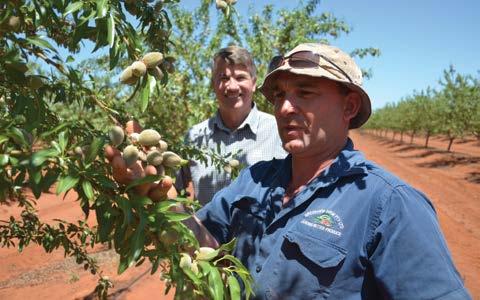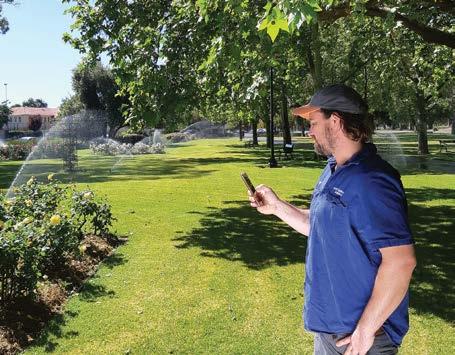
4 minute read
Technology: Rural
IRRIGATION, VERSATILITY, SUCCESS IN A NUTSHELL
Improving their farm's versatility was the priority when Jamie and Marie Schembri planted almonds in 2015 on their farm, Greenview, near Griffith in the centre of the Murrumbidgee Irrigation Area in New South Wales.
Jamie and Marie previously focused on annual horticulture crops including watermelons and rockmelons, but a scare with a melon virus in the early 2000s prompted the change of strategy to a perennial tree crop.
The first stage of their expansion was 180 ha of almond trees, and they've since planted a second stage of another 250 ha. According to Jamie, adding the almonds has taken considerable investment in plant stock and irrigation system set up, but their calculations indicated that there would be a positive on the balance sheet. "For us the negative side of that is the initial water use but the return on investment on water will still play towards the nuts," Jamie said.
Standing them in good stead is their experience with irrigation. The Schembris have worked in irrigation for the best part of 25 years, starting with Jamie's parents before they started their own farms at Cowra and Eugowra. They made the move to Greenview Farm in 2011.
Jamie Schembri says that the investment in drip irrigation for the family’s 430 ha of almonds is a significant one that will pay off over time. (Background: Michael Lenehan from Toro)
Do it right, the first time To maximise the benefits from irrigating, Jamie knew that things had to be done correctly and to best practice standard, starting with designing the system. Their certified irrigation designer worked with satellite imagery to plan out the orchard.
Working from the industry standard, the trees are planted 5 m from each other, 7 m between each row.
Jamie went with Toro equipment, in part because of his long-standing relationship with them. The designer recommended pressure-compensating drip tube, which Toro supplied from its Neptune range.
The tube is designed to ensure a consistent spread of water across the almond grove, and the pressure compensation means the flow rate is the same all along the line. Importantly, their investment is a long-term one with the tube expected to last 15 years with regular maintenance.
Water is supplied from a dam and is piped into several tanks and filters before being distributed around the orchard.
Lessons learned after first season This season is set to be the first that almonds will be harvested, after concern about the health of the trees saw harvest missed in 2018.
The almond trees initially had one line of drip tube delivering a mix of water and fertiliser. "On stage one we ran single for two years, and then put in a second on year three, but we found that we would have been better off putting two tubes at the start," Jamie explained.
Drafting WET

Pressure-compensating drip tube has been installed down both sides of each row of almond trees.




The two tubes on either side help encourage a better and more stable root system.
Jamie said almonds could have first been harvested in the third year, however, they held off to protect the trees' health and ensure their root systems weren't disrupted. "We left (harvest) last year because we didn't want to shake the trees," Jamie said.
Since planting the second stage of the almond grove, the Schembris have used two lines of drip tube, which has been manufactured to a custom length. This helps ensure there's no waste when it's laid down alongside the trees.
It also means the Schembris don't have to cut or add tubing, and using fewer joiners in the tube means there's a smaller risk of leaks. It can simply be rolled out and connected.
Four varieties of almond tree were planted in the first stage – Nonpareil, Monterey, Supa Pareil and Wood Colony. Only Nonpareil and Shasta varieties were planted at the second stage. Nonpareil makes up around half the plantation, which is standard industry practice. The trees were all sourced from a Griffith nursery.
Unlike row crops, which can have plastic covering the ground to reduce competition from weeds, Jamie said keeping the almond grove free from weeds was a challenge.
Dust settling on the weeds makes certain chemicals inert meaning spraying must be done soon after rain.
Keeping it on the farm As well as the investment in setting up the almond orchard, the Schembris will do their own harvesting and are importing specialised equipment from the United States.
Doing their own harvesting gives the Schembris the chance to maintain an element of control in the process as well as ensuring their 10 permanent staff have work.
The nuts are usually harvested around February to March and they'll be taken to a de-shelling factory in Griffith before going for further processing.
Note. Article provided by Toro Australia.










